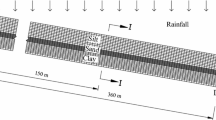Abstract
The cover system is a key factor in the management of waste disposal sites. Traditional methods of cover design based on empirical and semi-quantitative analysis have been improved upon by the effective use of models to assess the evapotranspiration, runoff, and infiltration volumes associated with different cover configurations. The Hydrologic Evaluation of Landfill Performance (HELP) model developed for the United States Environmental Protection Agency allows cover performance prediction with a sound technical basis.
The HELP model was used to assess four alternative cover designs ranging from simple, two-layer systems to more complex systems incorporating multiple drainage layers and synthetic membrane barriers. A sensitivity study was performed to determine the relative imcorporating cover design parameters such as clay barrier thickness and hydraulic conductivity, synthetic membrane leakage factor, and the length and slope of drainage layers.
The results of the study can be used to identify cover designs that reduce infiltration, increase evapotranspiration, and provide manageable volumes of surface runoff within the site vicinity. The modelling indicated that more complex cover systems are not necessarily superior to simpler ones. Efficient cover systems can be achieved by concentrating the engineering design effort on several critical parameters such as the hydraulic conductivity of clay barriers and the leakage factor of synthetic membranes. Other factors, commonly considered important, such as clay barrier thickness and drainage layer design, appear to be less significant.
Résumé
Le recouvrement est le facteur-clé de la gestion des sites de mise en dépôt des déchets.
Les méthodes traditionnelles fondées sur l'analyse empirique et semi-quantitative ont été améliorées par l'utilisation de modèles prenant en compte les volumes liés à l'évapotranspiration, au ruissellement et à l'infiltration pour différents types de recouvrements. Le modèle d'évaluation hydrologique du comportement des décharges mis au point pour l'Agence de Protection de l'Environnement des Etats-Unis permet de prévoir le comportement des recouvrements à partie d'une base technique saine.
Le modèle a été utilisé pour évaluer quatre conceptions de recouvrements, dequis des systèmes simples à deux couches jusqu'à des systèmes plus complexes, incluant plusieurs couches drainantes et des membranes en matériau synthétique jouant le rôle d'écrans. Une étude a été faite pour déterminer l'importance relative des divers paramètres intervenant dans la conception des recouvrements tels que l'épaisseur des couches argileuses, leur conductivité hydraulique, les pertes par infiltration dans les membranes synthétiques et la longueur et la pente des couches drainantes.
Les résultats de l'étude peuvent être utilisés pour définir des systèmes de recouvrement réduisant l'infiltration, augmentant l'évapotranspiration et fournissant des possibilités de ruissellement de surface dans le voisinage du site. La modélisation a montré que des systèmes de recouvrement complexes n'étaient pas obligatoirement meilleurs que les simples. Des systèmes efficaces peuvent êtres obtenus en concentrant l'effort de conception sur plusieurs paramètres critiques, tels que la conductivité hydraulique des couches-barrières d'argile et le facteur d'infiltration des membranes synthétiques. D'autres facteurs, que l'on considère ordinairement comme importants tels que l'épaisseur des couches-barrières d'argile ou la conception des couches drainantes, semblent en fait moins significatifs.
Similar content being viewed by others
References
BROWN S.M., DONIGIAN A.S., YABUSAKI S.B. and BACHMAIER J.T., 1986: Locational factors affecting leachate migration. Environmental Engineering—Proceedings of the 1984 Specialty Conference, A.S.C.E., pp. 609–614.
Environment Canada, 1982a: Canadian Climatic Normals Volume 1: Solar Radiation 1951–1980, 57 pp.
Environment Canada, 1982b: Canadian Climatic Normals 1951–1980: Temperature and Precipitation Ontario, 254 pp.
Ertec Atlantic Inc., 1983. Draft Final—Liner/Locational Analysis Project. Prepared for US EPA, Solid Waste Branch, 84 pp.
GEE J.R., 1981: Prediction of Leachate Accumulation in Sanitary Landfills. Proceedings of Fourth Annual Madison Conference of Applied Research and Practice on Municipal and Industrial Waste, pp. 170–190.
GIBSON A.C. and MALONE P.G., 1982: Verification of the U.S. EPA HSSWDS hydrologic simulation model. Land Disposal of Hazardous Waste—Proceedings of the Eighth Annual Research Symposium (U.S. EPA), pp. 475–485.
HIMS A.G., LEE P.K. and GILLHAM R.W., 1984: Field measurement of infiltration through landfill covers. Seminar on the Design and Construction of Municipal and Industrial Waste Disposal Facilities Proceedings, Toronto, pp. 158–173.
LUTTON R.G., 1980: Evaluating cover systems for solid and hazardous waste. US Environmental Protection Agency Report No. SW-867, 57 pp.
McIELWAIN T.A. and READES D.W., 1985: Status report: The use of engineered covers at waste disposal sites. Proceedings of the Second Annual Canadian/American Conference on Hydrogeology, Banff, Alberta.
SCHROEDER P.R., MORGAN J.M., WALSKI T.M. and GIBSON A.C., 1983): The Hydrologic Evaluation of Landfill Performance (HELP) Model—Draft Final Volumes I and II, US Environmental Protection Agency, Washington, 256 pp.
SCHRUBEN T.C. and J.J. BONE, 1984: HELP model applications to percolation through uranium mill tailings remedial action cover systems. Environmental Engineering—Proceedings of the 1984 Specialty Conference, A.S.C.E., pp. 609–614.
Author information
Authors and Affiliations
Rights and permissions
About this article
Cite this article
Hollingshead, S.C., Kennedy, K.G. & Anderson, E.G. Improved facility management at landfills and waste disposal sites by cover system design analysis. Bulletin of the International Association of Engineering Geology 37, 27–37 (1988). https://doi.org/10.1007/BF02590368
Published:
Issue Date:
DOI: https://doi.org/10.1007/BF02590368




